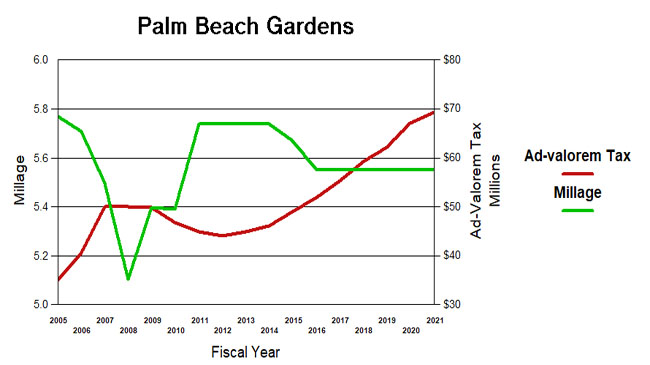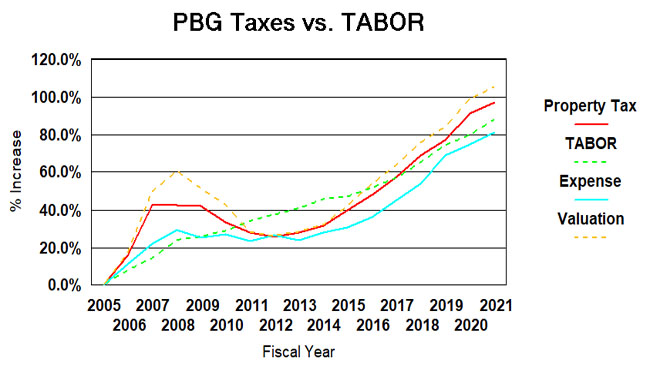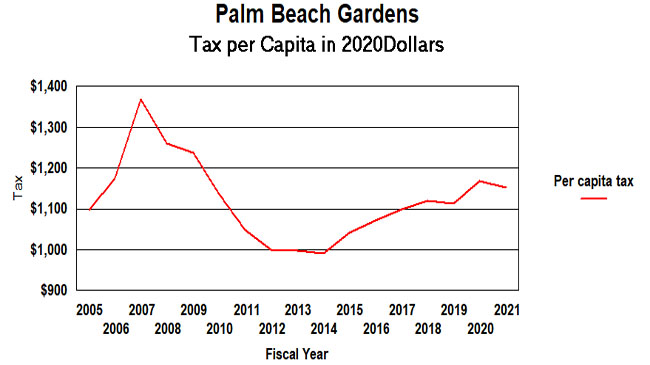Modest 3.1% Tax Increase in 2021 Budget
Posted by Fred Scheibl on September 7, 2020 · Leave a Comment
The proposed 2021 PBG Budget raises about $2M in new taxes, up a modest 3.1% over last year. See the Proposed Budget here.
With the millage flat at 5.55 since reduced to that level in 2016, this is the sixth year that increases in property valuations and new construction have provided an equivalent increase in revenue without raising the tax rate. In 2015, ad-valorem revenue was $49M. This year’s $69M is a 41% increase over the six years of flat millage.
If you add in the effect of the 10 year 1% sales tax surcharge which gives the city about another $3M per year, the increase over 2015 is actually about 47%.
You may recall that prior to the passage of the sales tax surcharge in 2016, PBG staff had said they didn’t need any additional sources of funds, and if it passed, would return some to the taxpayers in a millage reduction. That too changed of course when the full 10 year revenue stream was captured in a bond and allocated to projects starting immediately, including $11M for the new district park.
Assuming the flat millage budget is passed as proposed, the 3.1% tax increase compares to an estimated increase in population of about 3% and mild inflation of about 1% (July to July CPI change), so the increase is about what economic conditions would expect, although the effects of the Covid-19 shutdowns make it hard to project into the future.

TABOR
In 1992, the state of Colorado amended their constitution to restrict the growth of taxation. Under the “Taxpayer Bill of Rights” (TABOR), state and local governments could not raise tax rates without voter approval and could not spend revenues collected under existing tax rates without voter approval if revenues grow faster than the rate of inflation and population growth. The results of this Colorado experiment are mixed, and TABOR has its pros and cons. (For background on TABOR, see: Taxpayer Bill of Rights ) Population growth and inflation though, would seem to be a way of assessing the appropriateness of the growth of a city budget, at least as an initial benchmark.
Since 2005, the population of Palm Beach Gardens will have grown by about 41% (BEBR estimate – see below) to its estimated 2021 level of 59K. Inflation, measured by the consumer price index, will be about 33%. Taken together, TABOR would suggest a growth in city spending and taxation of about 88%. (see graph below).
Over the same period (2005-2021), ad-valorem taxes grew 97% and total expenditures (budget less debt payment, capital and transfers) grew 81%. Spending closely follows the TABOR line, and ad-valorem taxes is not widely divergent (although exceeding TABOR since 2017) suggesting spending and taxation appropriate to a growing city.
It should be noted that ad-valorem taxes fund only a part of city expenditures, the rest made up from impact fees, fees for services, other taxes, intergovernmental grants, etc. and have varied from 66% of the total in 2005 to about 70% now. That is why taxes and expenses do not track each other on the chart.

Another useful measurement is taxes per capita – Ad valorem taxes divided by population and then inflation adjusted. By this measure, in 2005 we paid $1,097 per person to our city and in 2021 it will be $1,152 (2020 dollars). Although not too far above the 2005 level, tax per capita was as low as $990 in 2014 after a millage reduction. It should be noted that as property owners, we pay taxes to other entities besides the city – county, schools, health care district, etc. In 2019 the Palm Beach Gardens portion of the amount on our TRIM statement is about 27% of the total.
The chart below shows an actual decline in per-capita taxation, yet there is reason to believe the BEBR population estimates have missed some of the city’s growth (see below). If the numbers are adjusted to match the growth in voter registrations since 2016 for example, the curve is much flatter since there are more people to pay the taxes.

So if you trust TABOR, or per-capita as measuring sticks, this modest growth in taxation for 2021 seems appropriate in our view. You be the judge.
A word about population estimates.
Estimates of the Gardens population vary. The numbers used in the preceding two charts are based on the University of Florida’s Bureau of Business and Economic Research (BEBR) data. By their measure, we have grown 33.6% to 2020 since 2005, and 2.3% in the last year. The US Census has a different set of numbers and they claim 37.3% and 1.4% respectively. BEBR says we had 55,621 residents in 2019. the Census said 57,067. Projecting to 2021 at the same rates would get approximately 59K by both measures.
I have reason to believe that both of these estimates are too low. In 2017, the city annexed Osprey Isles and Carleton Oaks (about 650 residents) and in 2018 Bay Hill and Rustic Lakes (aobut 1340 residents). It is not clear that either BEBR or the census adjusts for annexations between census decennials. Also, certain areas of the city are growing rapidly, such as Alton and soon Avenir.
If you look at voter registration data, assuming that the population as a whole was growing at the same rate as the voter rolls, you see more rapid growth. In 2016 there were 37,878 registered voters in the Gardens, 74% of the population based on BEBR. Today (August 2020), the voter rolls have grown to 45,923, up 21%. A similar ratio applied to population would yield 62,457 residents in 2020, and by extension, 63,890 in 2021. Precinct 1190 (which includes Alton and is now the largest precinct in the county) now has about 4800 voters. In 2014 it had about 2500.
